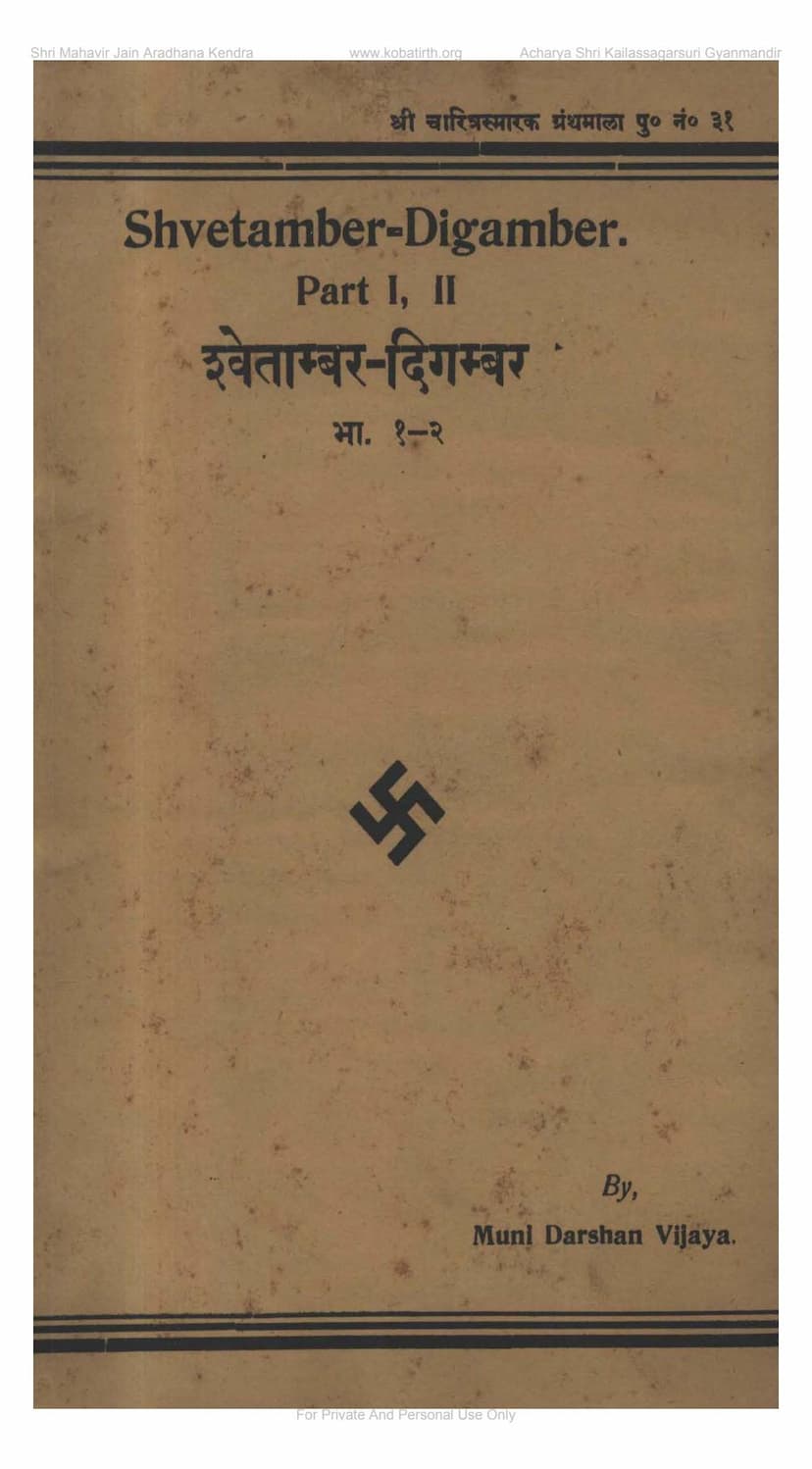Shvetambar Digamber Part 01 02
Added to library: September 2, 2025

Summary
This is a summary of the Jain text "Shvetambar Digamber Part 01 02" by Muni Darshanvijaya, published by Mafatlal Manekchand Shah. The book is part of the Shri Charitrasmarak Granthamala, publication number 31. The core purpose of this book is to reconcile and present a harmonious view of the Shvetambar and Digambar traditions within Jainism.
Here's a breakdown of the key aspects covered in the provided text:
1. Origin and Purpose:
- The book was prompted by a letter from Muni Sukhamuniji, questioning why Muni Darshanvijaya hadn't responded to criticisms against Jain Agamas and the Shvetambar community in a book titled 'Kalpit Katha Samiksha'.
- Muni Darshanvijaya states that after studying Digambara scriptures extensively, he decided to present a harmonious synthesis (समन्वय - samanvay) rather than a refutation.
- This work, "Shvetambar-Digamber," aims to bridge the differences between the two major sects.
2. Core Argument for Harmony:
- The author argues that true Jainism, characterized by Sammat Darshan (Right Faith), Samyak Gyan (Right Knowledge), and Samyak Charitra (Right Conduct), and guided by Syadvada (the doctrine of conditioned predication), is inherently universal.
- He contends that the Digambar sect, by emphasizing its specific tenets (like nudity), has become exclusive (एकान्तवाद - ekantavad), thus limiting its universal appeal.
- The author believes that true Jain Dharma is achieved through the integration (एकीकरण - ekikaran) of the real truths found in both Shvetambar and Digambar traditions, fostering an Anekant (non-one-sided) perspective.
3. Historical Context of Differences:
- The text traces the origins of some differences back to the time of Lord Mahavir, suggesting that two other monastic traditions (sanghas) merged with his original Shraman Sangha:
- Lord Parshvanath's tradition: Characterized by Chatur-yam (four vows) and the wearing of colored clothes. This tradition is linked to groups like the Upakesha Gachha.
- Mankhali Gosala's tradition: Primarily practiced nudity, with some disciples entering Lord Mahavir's Sangha. This tradition is linked to groups like the Ajivaka and later the Digambaras.
- It's mentioned that for about 600 years, the Shraman Sangha remained undivided, without strict adherence to either clothing or nudity, or bias towards either gender.
- Later, the emphasis on Digambar-hood (दिगम्बरत्व - digambarattva) led to a split, with some adopting practices like the absorption of water from vessels, which the author presents as evidence of historical Digambar practices that differ from current ones.
4. Key Areas of Contention and Harmonization Discussed: The book delves into various points of difference between the two traditions, aiming to find common ground or explain the divergences:
- Nudity vs. Clothing (नग्नता / वस्त्र - nagnta / vastra): This is presented as a major point of contention. The author argues that the core principle is non-possession (परिग्रह - parigraha), which is defined as attachment (ममत्व - mamtva), not necessarily the objects themselves. He cites Digambar scriptures that allow for certain possessions (like the peacock feather) and discusses the concept of Upadhi (possessions). He also analyzes the meaning of "Achilak" (अचेलक) and suggests it might mean "minimal clothing" rather than absolute nudity.
- Celibacy and Monastic Conduct (मुनि आचार - muni achar): Discussions revolve around the strictness of vows, the nature of monastic life, and acceptable practices.
- Status of Women (स्त्री - stri): The text addresses the controversial issue of women's liberation and their ability to attain moksha, citing scriptural passages and interpretations from both traditions.
- Kevali (Omniscient Beings): The nature of their existence, their conduct, their "non-obstructing" (नोकर्म - nokarma) food, and their practices are discussed.
- Tirthankaras and Their Lives (तीर्थंकर - tirthankar): The book examines the birth, conduct, miracles (atishay), and teachings of Tirthankaras, highlighting differences in interpretation.
- Scriptural Interpretation (शास्त्र - shastra): A significant portion of the text involves quoting and analyzing passages from various Jain scriptures, both Shvetambar and Digambar, to support the arguments for reconciliation.
- "Anekant" Philosophy: The author frequently returns to the principle of Anekantavada as the key to understanding and resolving differences, emphasizing that truth can be viewed from multiple perspectives.
5. Author's Approach:
- Muni Darshanvijaya emphasizes a scriptural and logical approach, aiming to present evidence from both traditions to show their underlying unity.
- He expresses humility regarding potential errors in his Hindi, given it's not his mother tongue, and asks for understanding from the readers.
- The author offers an apology (मिच्छामि दुक्कडं - michchhami dukkadam) for any unintentional misstatements.
6. Overall Goal: The ultimate aim of "Shvetambar-Digamber" is to foster mutual understanding and unity within the Jain community by demonstrating that the core principles of Jainism are shared, even if certain practices or interpretations have diverged over time. The book seeks to showcase that a harmonious integration (समन्वय - samanvay) is not only possible but essential for the universal propagation of Jain Dharma.